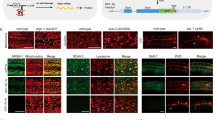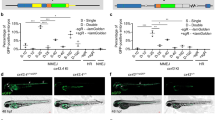Abstract
Transgenic multicolor fluorescence reporters enable the visualization of alternative splicing patterns at a single-cell resolution in living organisms and facilitate further genetic analyses to identify cis-elements and trans-acting factors involved in splicing regulation. In this paper, we describe a method of generating fluorescence alternative splicing reporters for the nematode Caenorhabditis elegans. We describe strategies for designing minigene reporters and methods for constructing them; DNA fragments ('modules', such as promoter/3′ cassettes, a genomic fragment of interest and a fluorescent protein cassette) that exist in separate vectors are assembled using site-directed recombination. We also describe strategies and methods for mutant screening and single-nucleotide polymorphism mapping using fluorescence reporters. This is the first detailed description of the design and construction of fluorescence alternative splicing reporters for C. elegans and their use in subsequent genetic analyses. It takes 2–4 months to construct minigenes and generate extrachromosomal lines for visualizing spatiotemporal distribution of alternative splicing events in vivo. Identification of regulators by integration of transgenes, mutant screening and mapping of the responsible genes takes a further 6–12 months. The fluorescence-reporter construction described here can also be applied to the vertebrate cell culture system.
This is a preview of subscription content, access via your institution
Access options
Subscribe to this journal
Receive 12 print issues and online access
$259.00 per year
only $21.58 per issue
Buy this article
- Purchase on Springer Link
- Instant access to full article PDF
Prices may be subject to local taxes which are calculated during checkout




Similar content being viewed by others
References
Wang, E.T. et al. Alternative isoform regulation in human tissue transcriptomes. Nature 456, 470–476 (2008).
Matlin, A.J., Clark, F. & Smith, C.W. Understanding alternative splicing: towards a cellular code. Nat. Rev. Mol. Cell. Biol. 6, 386–398 (2005).
Black, D.L. Mechanisms of alternative pre-messenger RNA splicing. Annu. Rev. Biochem. 72, 291–336 (2003).
Jin, Y. et al. A vertebrate RNA-binding protein Fox-1 regulates tissue-specific splicing via the pentanucleotide GCAUG. EMBO J. 22, 905–912 (2003).
Jensen, K.B. et al. Nova-1 regulates neuron-specific alternative splicing and is essential for neuronal viability. Neuron 25, 359–371 (2000).
Ladd, A.N., Charlet, N. & Cooper, T.A. The CELF family of RNA binding proteins is implicated in cell-specific and developmentally regulated alternative splicing. Mol. Cell. Biol. 21, 1285–1296 (2001).
Sheives, P. & Lynch, K.W. Identification of cells deficient in signaling-induced alternative splicing by use of somatic cell genetics. RNA 8, 1473–1481 (2002).
Wang, Z., Rolish, M.E., Yeo, G., Tung, V., Mawson, M. & Burge, C.B. Systematic identification and analysis of exonic splicing silencers. Cell 119, 831–845 (2004).
Ellis, P.D., Smith, C.W. & Kemp, P. Regulated tissue-specific alternative splicing of enhanced green fluorescent protein transgenes conferred by alpha-tropomyosin regulatory elements in transgenic mice. J. Biol. Chem. 279, 36660–36669 (2004).
Oltean, S. et al. Alternative inclusion of fibroblast growth factor receptor 2 exon IIIc in Dunning prostate tumors reveals unexpected epithelial mesenchymal plasticity. Proc. Natl. Acad. Sci. USA 103, 14116–14121 (2006).
Levinson, N. et al. Use of transcriptional synergy to augment sensitivity of a splicing reporter assay. RNA 12, 925–930 (2006).
MacMorris, M.A., Zorio, D.A. & Blumenthal, T. An exon that prevents transport of a mature mRNA. Proc. Natl. Acad. Sci. USA 96, 3813–3818 (1999).
Newman, E.A. et al. Identification of RNA-binding proteins that regulate FGFR2 splicing through the use of sensitive and specific dual color fluorescence minigene assays. RNA 12, 1129–1141 (2006).
Orengo, J.P., Bundman, D. & Cooper, T.A. A bichromatic fluorescent reporter for cell-based screens of alternative splicing. Nucleic Acids Res. 34, e148 (2006).
Warzecha, C.C., Sato, T.K., Nabet, B., Hogenesch, J.B. & Carstens, R.P. ESRP1 and ESRP2 are epithelial cell-type-specific regulators of FGFR2 splicing. Mol. Cell 33, 591–601 (2009).
Oltean, S., Febbo, P.G. & Garcia-Blanco, M.A. Dunning rat prostate adenocarcinomas and alternative splicing reporters: powerful tools to study epithelial plasticity in prostate tumors in vivo. Clin. Exp. Metastasis 25, 611–619 (2008).
Stoilov, P., Lin, C.H., Damoiseaux, R., Nikolic, J. & Black, D.L. A high-throughput screening strategy identifies cardiotonic steroids as alternative splicing modulators. Proc. Natl. Acad. Sci. USA 105, 11218–11223 (2008).
Bonano, V.I., Oltean, S. & Garcia-Blanco, M.A. A protocol for imaging alternative splicing regulation in vivo using fluorescence reporters in transgenic mice. Nat. Protoc. 2, 2166–2181 (2007).
Bonano, V.I., Oltean, S., Brazas, R.M. & Garcia-Blanco, M.A. Imaging the alternative silencing of FGFR2 exon IIIb in vivo. RNA 12, 2073–2079 (2006).
Takeuchi, A., Hosokawa, M., Nojima, T. & Hagiwara, M. Splicing reporter mice revealed the evolutionally conserved switching mechanism of tissue-specific alternative exon selection. PLoS One 5, e10946 (2010).
Zahler, A.M. Alternative splicing in C. elegans. in WormBook (ed. The C. elegans Research Community). doi:10.1895/wormbook.1.31.1, http://www.wormbook.org (26 September 2005).
Spike, C.A., Davies, A.G., Shaw, J.E. & Herman, R.K. MEC-8 regulates alternative splicing of unc-52 transcripts in C. elegans hypodermal cells. Development 129, 4999–5008 (2002).
Spartz, A.K., Herman, R.K. & Shaw, J.E. SMU-2 and SMU-1, Caenorhabditis elegans homologs of mammalian spliceosome-associated proteins RED and fSAP57, work together to affect splice site choice. Mol. Cell. Biol. 24, 6811–6823 (2004).
Spike, C.A., Shaw, J.E. & Herman, R.K. Analysis of smu-1, a gene that regulates the alternative splicing of unc-52 pre-mRNA in Caenorhabditis elegans. Mol. Cell. Biol. 21, 4985–4995 (2001).
Kabat, J.L., Barberan-Soler, S., McKenna, P., Clawson, H., Farrer, T. & Zahler, A.M. Intronic alternative splicing regulators identified by comparative genomics in nematodes. PLoS Comput. Biol. 2, e86 (2006).
Kuroyanagi, H., Kobayashi, T., Mitani, S. & Hagiwara, M. Transgenic alternative-splicing reporters reveal tissue-specific expression profiles and regulation mechanisms in vivo. Nat. Methods 3, 909–915 (2006).
Ohno, G., Hagiwara, M. & Kuroyanagi, H. STAR family RNA-binding protein ASD-2 regulates developmental switching of mutually exclusive alternative splicing in vivo. Genes Dev. 22, 360–374 (2008).
Kuroyanagi, H., Ohno, G., Mitani, S. & Hagiwara, M. The Fox-1 family and SUP-12 coordinately regulate tissue-specific alternative splicing in vivo. Mol. Cell. Biol. 27, 8612–8621 (2007).
Lander, E.S. et al. Initial sequencing and analysis of the human genome. Nature 409, 860–921 (2001).
David, C.J. & Manley, J.L. The search for alternative splicing regulators: new approaches offer a path to a splicing code. Genes Dev. 22, 279–285 (2008).
Kuroyanagi, H. Fox-1 family of RNA-binding proteins. Cell. Mol. Life Sci. 66, 3895–3907 (2009).
Mello, C.C., Kramer, J.M., Stinchcomb, D. & Ambros, V. Efficient gene transfer in C.elegans: extrachromosomal maintenance and integration of transforming sequences. EMBO J. 10, 3959–3970 (1991).
Van Buskirk, C. & Sternberg, P.W. Epidermal growth factor signaling induces behavioral quiescence in Caenorhabditis elegans. Nat. Neurosci. 10, 1300–1307 (2007).
Chang, Y.F., Imam, J.S. & Wilkinson, M.F. The nonsense-mediated decay RNA surveillance pathway. Annu. Rev. Biochem. 76, 51–74 (2007).
Isken, O. & Maquat, L.E. Quality control of eukaryotic mRNA: safeguarding cells from abnormal mRNA function. Genes Dev. 21, 1833–1856 (2007).
Pulak, R. & Anderson, P. mRNA surveillance by the Caenorhabditis elegans smg genes. Genes Dev. 7, 1885–1897 (1993).
Burgess, R.R. Use of bioinformatics in planning a protein purification. Methods Enzymol. 463, 21–28 (2009).
Brondyk, W.H. Selecting an appropriate method for expressing a recombinant protein. Methods Enzymol. 463, 131–147 (2009).
Mello, C.C. & Fire, A. DNA transformation. in Caenorhabditis elegans: Modern Biological Analysis of an Organism (eds. Epstein, H.F. & Shakes, D.C.) 452–482 (Academic Press, San Diego, 1995).
Clark, S.G., Lu, X. & Horvitz, H.R. The Caenorhabditis elegans locus lin-15, a negative regulator of a tyrosine kinase signaling pathway, encodes two different proteins. Genetics 137, 987–997 (1994).
Mitani, S. Genetic regulation of mec-3 gene expression implicated in the specification of the mechanosensory neuron cell types in Caenorhabditis elegans. Dev. Growth Differ. 37, 551–557 (1995).
Caceres, J.F. & Kornblihtt, A.R. Alternative splicing: multiple control mechanisms and involvement in human disease. Trends Genet. 18, 186–193 (2002).
Wicks, S.R., Yeh, R.T., Gish, W.R., Waterston, R.H. & Plasterk, R.H. Rapid gene mapping in Caenorhabditis elegans using a high density polymorphism map. Nat. Genet. 28, 160–164 (2001).
Ryder, S.P., Recht, M.I. & Williamson, J.R. Quantitative analysis of protein-RNA interactions by gel mobility shift. Methods Mol. Biol. 99–115 (2008).
Clarke, P.A. Labeling and purification of RNA synthesized by in vitro transcription. in RNA-Protein Interaction Protocols (ed. Haynes, S.R.) 1–10 (Humana Press, Totowa, New Jersey, 1999).
Ohno, M. & Shimura, Y. Nuclear cap binding protein from HeLa cells. Methods Enzymol. 181, 209–215 (1990).
Johnstone, I.L. Molecular biology. in C. elegans: A Practical Approach (ed. Hope, I.A.) 201–225 (Oxford University Press, New York, 1999).
Inoue, H., Nojima, H. & Okayama, H. High efficiency transformation of Escherichia coli with plasmids. Gene 96, 23–28 (1990).
Goodman, S.J., Branda, C.S., Robinson, M.K., Burdine, R.D. & Stern, M.J. Alternative splicing affecting a novel domain in the C. elegans EGL-15 FGF receptor confers functional specificity. Development 130, 3757–3766 (2003).
Graham, P.L., Johnson, J.J., Wang, S., Sibley, M.H., Gupta, M.C. & Kramer, J.M. Type IV collagen is detectable in most, but not all, basement membranes of Caenorhabditis elegans and assembles on tissues that do not express it. J. Cell. Biol. 137, 1171–1183 (1997).
Sibley, M.H., Johnson, J.J., Mello, C.C. & Kramer, J.M. Genetic identification, sequence, and alternative splicing of the Caenorhabditis elegans alpha 2(IV) collagen gene. J. Cell. Biol. 123, 255–264 (1993).
Kostas, S.A. & Fire, A. The T-box factor MLS-1 acts as a molecular switch during specification of nonstriated muscle in C. elegans. Genes Dev. 16, 257–269 (2002).
Galarneau, A. & Richard, S. Target RNA motif and target mRNAs of the Quaking STAR protein. Nat. Struct. Mol. Biol. 12, 691–698 (2005).
Acknowledgements
We thank A. Fire, H.R. Horvitz, R.Y. Tsien and A. Miyawaki for materials. We thank the present and past members of Masatoshi Hagiwara lab for their suggestions. We thank M. Hagiwara, H. Ito, Y. Kikuchi, T. Yamada and K. Kawamata for technical assistance. We thank Caenorhabditis Genetics Center for strains. We acknowledge support from grants from the Ministry of Education, Culture, Sports, Science and Technology (MEXT), the Japan Society for the Promotion of Science and the Japan Science and Technology Agency (JST).
Author information
Authors and Affiliations
Contributions
H.K. designed and performed the experiments, and wrote the paper; G.O., H.S. and H.M. designed and performed the experiments to improve the procedure; M.H. organized the study.
Corresponding authors
Ethics declarations
Competing interests
The authors declare no competing financial interests.
Supplementary information
Supplementary Sequence Archive
Sequence information of the fluorescent protein cassettes in pENTR-L5-L2 Entry vectors (PDF 15 kb)
Rights and permissions
About this article
Cite this article
Kuroyanagi, H., Ohno, G., Sakane, H. et al. Visualization and genetic analysis of alternative splicing regulation in vivo using fluorescence reporters in transgenic Caenorhabditis elegans. Nat Protoc 5, 1495–1517 (2010). https://doi.org/10.1038/nprot.2010.107
Published:
Issue Date:
DOI: https://doi.org/10.1038/nprot.2010.107
This article is cited by
-
Therapeutic manipulation of IKBKAP mis-splicing with a small molecule to cure familial dysautonomia
Nature Communications (2021)
-
Quantitation of the neural silencing activity of anion channelrhodopsins in Caenorhabditis elegans and their applicability for long-term illumination
Scientific Reports (2019)
-
Phosphorylation of the RSRSP stretch is critical for splicing regulation by RNA-Binding Motif Protein 20 (RBM20) through nuclear localization
Scientific Reports (2018)
-
Sorting nexin 3 mutation impairs development and neuronal function in Caenorhabditis elegans
Cellular and Molecular Life Sciences (2018)
-
Modulation of aberrant splicing in human RNA diseases by chemical compounds
Human Genetics (2017)
Comments
By submitting a comment you agree to abide by our Terms and Community Guidelines. If you find something abusive or that does not comply with our terms or guidelines please flag it as inappropriate.



